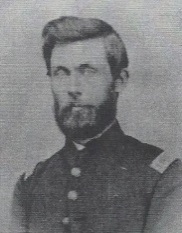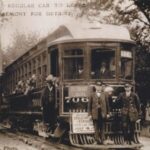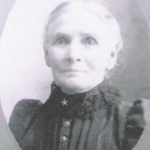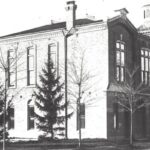
Many of these parents were members of the Baptist Church and three of the five school board members were also members of the Baptist Church. Eventually some of these parents asked the superintendent to exclude the young lady from school. Superintendent Bristol refused to exclude the girl. His explanation to the parents was that there was no legal reason to do so. The girls conduct and school work were all of acceptable levels and only for those reasons would he exclude her. The superintendent did have a physician from the state health department make an examination of the girl and of certain other pupils. This action only added to the criticism about the girl’s presence.
On March 16, 1927, the school board passed a motion to extend Mr. Bristol’s contract to cover the 1927-1928 school year. However, they did not actually have a contract ready for approval. A few days later, the school board met because of the turmoil surrounding Mr. Black and the young lady. At that meeting, the school board rescinded its offer to Mr. Bristol and passed a motion to hire Mr. Black as superintendent for the 1927-1928 school year.
About this time, an employee of the Girls’ Training School had come and taken the young lady back to Adrian. She was there only a few days before she was released. She had completed her sentence. Upon returning to Almont, she did not return to school. Several persons who wanted to allay the agitation of the girl’s presence at school had asked her sister and her mother, who lived in Imlay City, to keep her out of school. The women agreed and the girl did not return.
On Tuesday, April 12, 1927, the high school students, except the seniors, staged a strike. They made banners praising Mr. Bristol and ones attacking Mr. Black and certain school board members. They then left school and marched downtown. Several members of the band lead them while they played a tune popular at the time, “Bye, Bye Blackbirds.” There was a report that some of the students actually when to Romeo and also marched there.
The next night, Wednesday, April 13, 1927, the school board met to discuss the trouble that was disrupting the school. After a lengthy and heated discussion, the school board persuaded the superintendent, Mr. Bristol; the high school principal, Mrs. Eunice Hough Johnson; and two teachers; Miss Anna Hough and Mr. Black to resign immediately. Essentially, this was the entire high school staff. Mrs. Johnson was honored with a dedication in the 1922 yearbook, “The Quill”.
The next day, a story about the district’s troubles was carried on the front page of the Battle Creek Enquirer, so the turmoil had attracted statewide attention.
On Monday, April 18, 1927, school reopened with a new superintendent, A. T. Hagerman from Detroit; a new principal, Miss Tessie Sperry from Mayville; and a new science teacher, Merwin Starling of Bad Axe. A new languages teacher had not yet been employed. It is not known if any effort was made to hold classes on Thursday and Friday of the previous week. The day passed without incident and it was hoped the troubles were over and the school and town could move on without any further problems.
That evening, several people noted smelling smoke but could not find its origin. Among those was Alfred Walker, the school’s custodian, who lived on North Main Street. About 9 pm, G. W. Anderson discovered the fire in the basement of the school but there were also fires on the second floor.
The fire alarm was sounded and the firemen responded under the leadership of Fire Chief Charles E. Lewis. Upon entering the basement, the firemen smelled an odor of kerosene. Mr. Walker arrived and went to the basement to retrieve a can of kerosene which he had purchased that morning. He threw it out of the basement but did not determine if any of it had been used. The firemen noted that the furnace was not lit. The fire was so intense and extensive that other local fire departments were called to assist. Romeo came with 20 men and Capac and Richmond brought 15 men each.
The first order of fighting the fire was to get the basement fires extinguished. Once the basement was under control, firemen got on the roof and the second floor to fight those fires. Just as they seemed to be getting those fires under control, one of Almont’s firemen, Cleo Keller became overcome with smoke and heat and had to be removed from the roof. The fires flared during this lull and the roof and second floor could not be saved. After six hours, the fire was finally controlled. Firemen remained on the scene until about noon on Tuesday to put out hot spots and watch materials that were smoldering.
The fire destroyed the basement, the second floor and roof. The first floor was less extensively damaged by the fire but suffered from water and smoke damage. Students were able to get into the rooms on the first floor and retrieve their damaged belongings. The school records were removed from the second floor offices almost immediately after the fire was discovered. Fire Chief Lewis on Tuesday said that the circumstances seemed to indicate unmistakably that the fire was intentionally set, but that there was no positive proof at that time. Both Sheriff Courter and the state police investigated the origin of the fire.
While working on the farm, William Jr. was an avid learner. He attended the old red school in the Scotch Settlement (location unknown). Beginning when he was twenty-one, he would help on the farm and teach during the winters. He was continuing his education by taking classes at the Dickinson Institute in Romeo and the Union School in Ann Arbor with the intention of attending the University of Michigan.
The outbreak of the Civil War put his intentions to attend the University of Michigan on hold. He enlisted on August 8, 1862 in Company B, 22nd Michigan Infantry as a sergeant. Before leaving for the service, William married Sarah Rebekeh Stone of Ray Township, Macomb County on August 29, 1862 in Rochester. The 22nd operated in the Western Theater, primarily in Kentucky, Tennessee, Alabama, and Georgia. William was promoted to Second Lieutenant on June 5, 1863.
The Battle of Chickamauga was fought on September 19th and 20th, 1863. On the 19th, Confederate General Bragg’s Army of Tennessee attacked Union General Rosecrans’ Army of the Cumberland, which was somewhat scattered across a 40-mile front. By the end of the day, Rosecrans was about to gather his forces and establish a defensive line. Much of the credit to saving the Union Army was given to Major General George Thomas, afterward known as the “Rock of Chickamauga”. On the 20th, the Confederates received reinforcements from the Army of Virginia and overwhelmed the Union forces. The Union forces retreated in disarray northward toward Chattanooga, Tennessee. Unfortunately, the 22nd was not one of the units that were rushing to the rear. They had held their line for four hours and were running out of ammunition. They began scavenging what they needed from the killed and wounded. As the sun went down, the 22nd discovered that they were surrounded. Some of the men played dead and others hid in the bushes but most of the men were captured. Lt. Hamilton, along with Colonel LaFavour, was sent to Libby Prison in Richmond, Virginia.
William remained a prisoner for 17 months. Starting in March 1864, the prisoners in Libby Prison were moved to other prisons. He was moved several times to prisons in Danville and Macon Georgia, Greensboro, North Carolina, and Charlottesville, Virginia. Finally, on March 1, 1865, William was paroled and passed through the Union lines to freedom. While a prisoner, he was promoted to First Lieutenant on November 17, 1863. He was mustered out of the service on June 26, 1865 and returned home.
After the conclusion of the Civil War, William and Sarah moved to Ann Arbor so William could begin his medical studies at the University of Michigan. While at Ann Arbor, their first two children were born: Arthur W. Hamilton was born December 23, 1865 and Walter B. Hamilton on July 15, 1867.
In June 1868, after receiving his medical degree, they moved to Burnside to set up his practice. After 18 months William moved the family to Columbiaville. However, shortly after settling in Columbiaville, both sons died. Walter died on February 13, 1870 and Andrew on the 23rd. Both daughters Helen Elizabeth (January 26, 1871) and Jean Margaret (September 9, 1972) were born in Columbiaville. In 1875, William moved the family home to Almont. It was at this time that he began researching and writing his “Short History of Almont, Lapeer County, Michigan”. He reviewed existing records and conducted interviews with the surviving original settlers and their children. By the following year – the centennial year – he had completed his history and it was published by the Almont Herald. In March through April 1911, the history was re-published as a series of articles. Much of what we know about the earliest history of Almont is the result of Dr. Hamilton’s efforts.
In 1877, he moved the family back to Columbiaville. Also, on the Fourth of July, 1877 he presented his history as a speech given to residence of Almont. Son Charles Andrew was born in Columbiaville on July 8, 1878.
In 1881 he was elected County Treasurer and moved the family to Lapeer.
When he moved the family back to the family homestead is not known with any certainty but it was prior to 1900. It is probable that he moved back after his father passed away in 1886. In his later years he farmed.
He had for many years written poetry and had it published. Most of the times his poems were published in local papers but occasionally in papers as far away as New York and Philadelphia. In 1904, several of his poems were included in the book “Michigan Poets and Poetry”. Possibly the best known of his poems was “The Rock of Chickamauga”, which was first published in the New York Post in 1875. His love of poetry may have stemmed from visits to James Thompson’s home when he was a teenager. Thompson regularly held meetings at his home where he read his own poetry (unfortunately, no known copies of these poems exist).
He died on November 1, 1918 in Berlin Township, St. Clair County. Sarah would follow in 1927. They were buried in the Willow Grove Cemetery in Armada.
William Bruce Hamilton, Jr.’s daughter Helen Elizabeth married Warren A. Finch and they had one son, William W. Finch, who died at age eleven or twelve. Helen and Warren lived in the house now occupied by Norman Hamilton.
Daughter Jean Margaret married Frank Elisha Lathrop from Armada and they would have one son, Laurence Barrows Lathrop. Laurence would marry a woman named Emma and they would move to New York and have three children, Ruth M., Doris J., and Laurence B. Ruth would marry a man by the name of Almy. Whether or not Ruth and her husband had children is not known. Doris married Edwin A. Riggs, Jr. and they would have two children, David and Janet. David would marry a woman named Jane and have a son, Peter. Whether Laurence B. married and had children is not known. Doris’ obituary does indicate that she had nieces and nephews.
William’s son Charles Andrew Hamilton died at age 25. His death certificate indicates that he was single.




